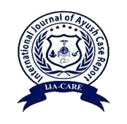Management of Avabhahuka (Frozen Shoulder) Through Sri Lankan Ayurveda Treatment Protocol: A Case Study
Abstract
Avabhahuka is a disease that affects the shoulder joint (Amsa sandhi) and it is manifested by the vitiated Vata dosha according to Ayurveda. Clinical features of Avabhahuka are mostly resembled to the frozen shoulder or adhesive capsulitis in modern medicine. The pain (Shoola) and stiffness (Sthabdhata) of the shoulder joint, with functional deficit (Bahupraspanditahara) leads huge impact on the quality of life of the patients suffering with Avabhahuka disease. It affects on middle age group community and occurs 2% of the general population and the diabetes patients are more prone to develop frozen shoulder. The study has been focused to manage the Avabhahuka disease based on the treatment principles mentioned in Ayurveda. A fifty six year old male patient diagnosed as Avabhahuka disease; presented with pain (Shoola), Stiffness (Stabdhata)and restricted movement (Bahupraspanditahara) in the right shoulder joint since five months was reported to the I.P.D, Department of Kayachikitsa, National Ayurveda Teaching Hospital , Borella, Sri Lanka was selected to the study. The treatment period was twenty eight days. The Patient was advised to take 120 ml of Rasanadi Kwata and 500mg of Triyodasanga Guggulutwo times per day after meal as internal treatments along with Griva Vasti, Dashamoola Nadi Sewda, and paste of Gaslabudiyalabu(Sri Lankan traditional paste) were administered as external treatments for initial consecutive fourteen days. Shad bindu Tailaya Nasya followed by Abyanga and sweda with Nikadi pottani carried out for next fourteen days. After completion of the treatment; it has been observed that, pain (Shoola) was completely cured. 66.6% relief was obtained in stiffness (Sthabdhata) and movement (Bahupraspanditahara)of the right shoulder joint. In view of the above; it can be concluded that the therapeutic protocol is effective for the disease Avabhahuka successfully.

